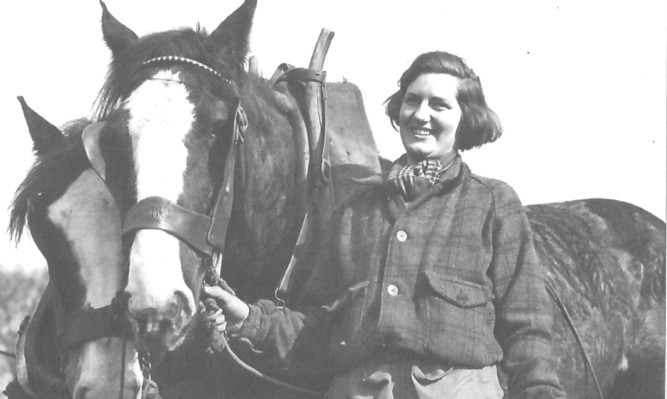During two world wars, members of the Women’s Land Army (WLA) gave up ordinary life and devoted themselves to producing food for a hungry nation.
With the passage of time there are not so many former members still with us. Of these, few can have a clearer memory of their service on the land than St Andrews resident Betty Reid.
Now happily ensconced in Balnacarron Care Home, Betty, 95, remembers hard days of physical work on Greenside Farm, Leven, with affection.
However, her particular passion is reserved for the Clydesdale horses which provided the motive power for every task.
“I instinctively understood these horses from the start. They were lovely creatures and deserved to be handled properly.
“Their size never bothered me even though I was a lassie straight from school,” she said.
Betty’s memories were rekindled by a recent article in The Courier’s farming pages by regular columnist Bill Howatson.
With a little encouragement from her friend Aileen Melville from Ceres, she was only too happy to take a wander down memory lane.
“These were dangerous times in the early 1940s, and I don’t think people now realise how close the country was to starvation,” she said.
“The men were away and the government thought ‘Why not give the lassies a chance?’
“I was one of those who answered the call.”
She admitted that it was quite a culture shock to go from a genteel upbringing in a musical family in Dunbar to a life of hard physical work.
“I was lucky, though: the farmer, Arthur Hutcheson, was a very fair man and a very good teacher,” she said. “The horses respected him and they were well trained. There was never any jiggling or bolting.
“There were two pairs of horses on the farm, and the foreman was Jim Wilson.” She added: “He stood no nonsense from man or beast, but he looked after me well and taught me how to do everything properly.
“I remember his cottage well, with its stone flag floors.
“He was always up at the farm first thing in the morning sorting the horses ready for the day’s work.
“I stayed in the farmhouse with the Hutchesons,” she said. “Instead of laughing at my early efforts, which would have been easy, everyone was kind and helped me.
“There were no concessions, though, when it came to work, and I was expected to do everything a man would do.
“I recall often driving cart-loads of potatoes to Montrave station and helping to load the wagons.”
Betty’s great love was ploughing with her pair, Flora and Bessy. There was no greater joy for her than ploughing a straight furrow on a fine winter’s morning singing her favourite song from Smetana’s Ma Vlast. “You could have heard me on the other side of the Forth!” she chuckled. “It is a beautiful piece of music and the title translates as ‘My Land.’
“Ploughing was a real science and I was well taught to match the last furrows of every rig with the one before.”
The early tuition and love of horses served Betty and the WLA well. After winning the champion’s medal at a ploughing match she went on to tutor other Land Girls in the skills of horsemanship.
“They had to understand that horses are living creatures. Clydesdales are wonderful animals but the girls had to be taught to treat them gently and never startle them or move quickly round about them,” she said.
“The girls lived in caravans while they were being taught.
“I hated tractors and still do. It was always horses for me.”
Aileen Melville confirmed that it is still the same and that when she drives Betty around the Fife countryside she is always quick to point out any tractor ploughing that is not up to the mark.
Asked what she thought of the modern practice at ploughing matches of having a person leading the horses as well as one between the shafts of the plough, she snorts “Jessies!” before having a quiet smile to herself.
In those wartime days at Greenside there was nobody to perform such a task, and in any event ploughing in those days was strictly a one-man or, in her case, one-girl operation.
